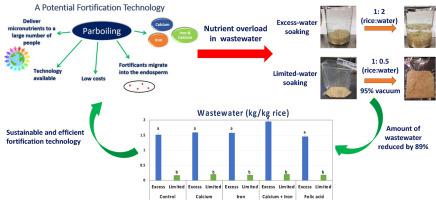当前位置:
X-MOL 学术
›
J. Cereal Sci.
›
论文详情
Our official English website, www.x-mol.net, welcomes your
feedback! (Note: you will need to create a separate account there.)
Development of a limited-water soaking method on the fortification of rice with calcium and iron by parboiling
Journal of Cereal Science ( IF 3.9 ) Pub Date : 2020-07-01 , DOI: 10.1016/j.jcs.2020.103014 Annegret Jannasch , Ya-Jane Wang
Journal of Cereal Science ( IF 3.9 ) Pub Date : 2020-07-01 , DOI: 10.1016/j.jcs.2020.103014 Annegret Jannasch , Ya-Jane Wang

|
Abstract Fortifying rice using parboiling has been shown to have a higher retention rate of nutrients and acceptable sensory characteristics. However, the conventional soaking step employs excess water and therefore generates large amounts of wastewater containing nutrients that, when discarded without treatment, can lead to nutrient overload in soil. A limited-water soaking method to fortify rice with calcium and iron by parboiling was developed and evaluated. Fortified rice quality attributes, mineral contents, the amount of wastewater, total solids in wastewater, washing-retention and bioavailability of calcium and iron were determined and compared with properties of rice that was fortified in excess-water soaking. The limited-water soaking method on average reduced the amount of effluent by 89% and the amount of total solids in wastewater by up to 85%. Rice fortified by the limited-water soaking method showed similar color and head rice yield, and slightly lower mineral uptakes compared to conventional soaking. Rice fortified simultaneously with calcium and iron in limited-water soaking contained about 999 mg Ca and 33 mg Fe per kg milled rice, and approximately 66% of calcium and 71% of iron remained in the rice after simulated washing. Calcium and iron dilute HCl-solubility was not affected by the soaking condition. Therefore, the limited-water soaking method can reduce the cost of fortification and wastewater treatment without affecting rice quality attributes.
中文翻译:

一种限水浸泡法蒸煮强化大米钙铁的方法
摘要 使用蒸煮强化大米已被证明具有更高的营养保留率和可接受的感官特性。然而,传统的浸泡步骤使用过量的水,因此会产生大量含有营养物质的废水,如果不经处理就丢弃,会导致土壤中的营养物质过载。开发并评估了一种通过预煮来强化大米钙和铁的限水浸泡方法。测定了强化大米的质量属性、矿物质含量、废水量、废水中的总固体、洗涤保留和钙和铁的生物利用度,并与在过量水浸泡中强化的大米的特性进行了比较。限水浸泡法平均减少了89%的出水量和85%的废水总固体含量。与传统浸泡法相比,通过限水浸泡法强化的大米具有相似的颜色和整粒米产量,矿物质吸收量略低。在限水浸泡中同时添加钙和铁的大米每公斤碾米含有约 999 毫克钙和 33 毫克铁,模拟洗涤后,大约 66% 的钙和 71% 的铁留在大米中。钙和铁的稀盐酸溶解度不受浸泡条件的影响。因此,限水浸泡法可以在不影响大米品质属性的情况下降低强化和废水处理的成本。与传统浸泡法相比,通过限水浸泡法强化的大米具有相似的颜色和整粒米产量,矿物质吸收量略低。在限水浸泡中同时添加钙和铁的大米每公斤碾米中含有约 999 毫克钙和 33 毫克铁,模拟洗涤后大米中保留了大约 66% 的钙和 71% 的铁。钙和铁的稀盐酸溶解度不受浸泡条件的影响。因此,限水浸泡法可以在不影响大米品质属性的情况下降低强化和废水处理的成本。与传统浸泡法相比,通过限水浸泡法强化的大米具有相似的颜色和整粒米产量,矿物质吸收量略低。在限水浸泡中同时添加钙和铁的大米每公斤碾米含有约 999 毫克钙和 33 毫克铁,模拟洗涤后,大约 66% 的钙和 71% 的铁留在大米中。钙和铁的稀盐酸溶解度不受浸泡条件的影响。因此,限水浸泡法可以在不影响大米品质属性的情况下降低强化和废水处理的成本。模拟洗涤后,大约 66% 的钙和 71% 的铁留在大米中。钙和铁的稀盐酸溶解度不受浸泡条件的影响。因此,限水浸泡法可以在不影响大米品质属性的情况下降低强化和废水处理的成本。模拟洗涤后,大约 66% 的钙和 71% 的铁留在大米中。钙和铁的稀盐酸溶解度不受浸泡条件的影响。因此,限水浸泡法可以在不影响大米品质属性的情况下降低强化和废水处理的成本。
更新日期:2020-07-01
中文翻译:

一种限水浸泡法蒸煮强化大米钙铁的方法
摘要 使用蒸煮强化大米已被证明具有更高的营养保留率和可接受的感官特性。然而,传统的浸泡步骤使用过量的水,因此会产生大量含有营养物质的废水,如果不经处理就丢弃,会导致土壤中的营养物质过载。开发并评估了一种通过预煮来强化大米钙和铁的限水浸泡方法。测定了强化大米的质量属性、矿物质含量、废水量、废水中的总固体、洗涤保留和钙和铁的生物利用度,并与在过量水浸泡中强化的大米的特性进行了比较。限水浸泡法平均减少了89%的出水量和85%的废水总固体含量。与传统浸泡法相比,通过限水浸泡法强化的大米具有相似的颜色和整粒米产量,矿物质吸收量略低。在限水浸泡中同时添加钙和铁的大米每公斤碾米含有约 999 毫克钙和 33 毫克铁,模拟洗涤后,大约 66% 的钙和 71% 的铁留在大米中。钙和铁的稀盐酸溶解度不受浸泡条件的影响。因此,限水浸泡法可以在不影响大米品质属性的情况下降低强化和废水处理的成本。与传统浸泡法相比,通过限水浸泡法强化的大米具有相似的颜色和整粒米产量,矿物质吸收量略低。在限水浸泡中同时添加钙和铁的大米每公斤碾米中含有约 999 毫克钙和 33 毫克铁,模拟洗涤后大米中保留了大约 66% 的钙和 71% 的铁。钙和铁的稀盐酸溶解度不受浸泡条件的影响。因此,限水浸泡法可以在不影响大米品质属性的情况下降低强化和废水处理的成本。与传统浸泡法相比,通过限水浸泡法强化的大米具有相似的颜色和整粒米产量,矿物质吸收量略低。在限水浸泡中同时添加钙和铁的大米每公斤碾米含有约 999 毫克钙和 33 毫克铁,模拟洗涤后,大约 66% 的钙和 71% 的铁留在大米中。钙和铁的稀盐酸溶解度不受浸泡条件的影响。因此,限水浸泡法可以在不影响大米品质属性的情况下降低强化和废水处理的成本。模拟洗涤后,大约 66% 的钙和 71% 的铁留在大米中。钙和铁的稀盐酸溶解度不受浸泡条件的影响。因此,限水浸泡法可以在不影响大米品质属性的情况下降低强化和废水处理的成本。模拟洗涤后,大约 66% 的钙和 71% 的铁留在大米中。钙和铁的稀盐酸溶解度不受浸泡条件的影响。因此,限水浸泡法可以在不影响大米品质属性的情况下降低强化和废水处理的成本。











































 京公网安备 11010802027423号
京公网安备 11010802027423号